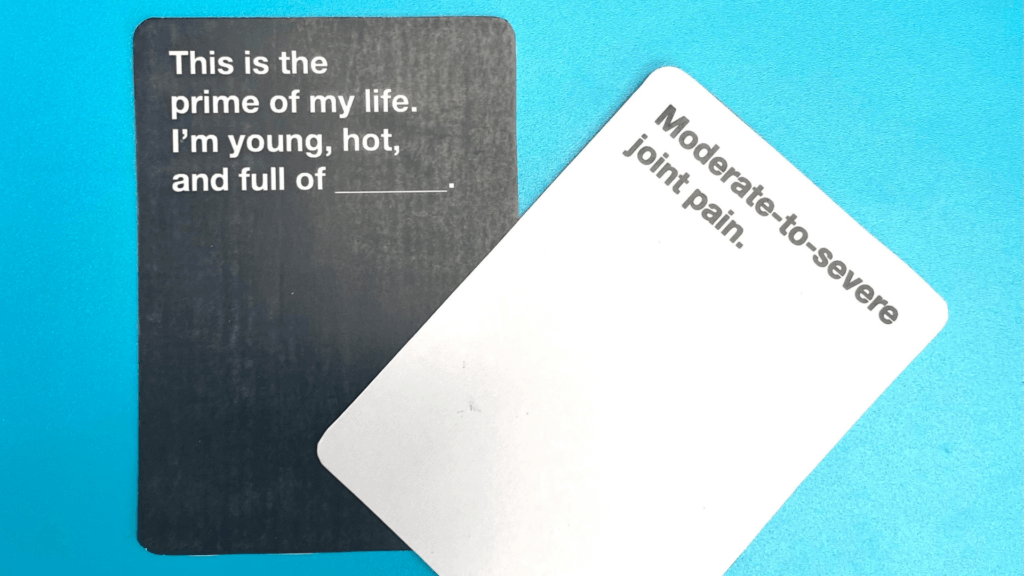Arthritis – Achy Joints Explained

According to the Arthritis Foundation℠, over 50 million Americans have arthritis, making it the number one cause of disability in the country. That means 1 in every 5 adults, 300,000 children and countless families. These numbers are only going to keep growing—unless we take a stand. The first steps in conquering arthritis are learning the facts, understanding your condition and knowing that help is by your side.
ARTHRITIS IS JUST ACHY JOINTS, RIGHT?
Arthralgia is the term which is used to describe “achy joints.” Arthritis, on the other hand, describes joints which are not only painful but also swollen, warm to touch and with limited mobility. Arthritis is not a single disease. There are over 100 types of arthritis and rheumatic diseases, the most common being osteoarthritis (OA).
WHAT IS RHEUMATOID ARTHRITIS?
Rheumatoid Arthritis (RA) is an autoimmune disease which typically presents as a bilateral, symmetric small joint arthritis affecting mostly the hands and feet. Although arthritis is the primary manifestation, RA is a systemic process which can have extra-articular manifestations as well.
I’M UNDER 40. COULD I REALLY HAVE ARTHRITIS?
Absolutely. Arthritis can affect anyone. Over 2/3 of those affected are under the age of 65.
WHAT SYMPTOMS SHOULD I LOOK FOR?
Aside from arthritis, one may also experience more systemic symptoms such as patchy hair loss, skin rashes, ulcers in nose/mouth, inflammation of eye, chest pain, shortness of breath, skin color changes of fingers/toes in cold, etc.
HOW CAN THE DOCTOR TELL I HAVE IT?
With a thorough history, physical exam and use of additional test such as labs and imaging, a diagnosis can be made.
WHAT ABOUT EXERCISING?
Exercise is a great thing! It actually helps arthritis by aiding in weight loss, which is the most modifiable risk factor for OA, and helps strengthen the muscles around the joints which will provide them with more support.
ANY PRECAUTIONS TO TAKE BEFORE EXERCISE?
It’s always important to discuss your diet/exercise plan with your doctor before starting in order to make sure it’s reasonable and healthy for you. For patients who have arthritis, I encourage a routine of regular, low impact aerobic exercise (i.e., three days per week) such as walking, using elliptical, recumbent bicycle or aqua therapy if possible. That being said, I tell patients any exercise is better than none, so do whatever you are able to and slowly build on that with time and treatment of their underlying disease process.
CAN I DO ANYTHING TO PREVENT ARTHRITIS?
Most types of arthritis are not “preventable” as there is a genetic predisposition for them; however, they can usually be well managed with the combination of medications and healthy lifestyle choices including no smoking, regular exercise and a healthy diet.
WHAT MEDICINES HELP?
This is very much dependent on what type of arthritis you have. That being said, most patients with arthritis will typically use over-the-counter medications such as Tylenol and/or an anti-inflammatory along with prescription medications to help control their arthritis and associated pain.
ARE THERE FOODS THAT EASE ARTHRITIS?
Gout is really the only arthritis which has known dietary triggers. For those patients, a diet to lower uric acid levels, along with medications prescribed by your doctor, make gout one of the most controllable forms of arthritis. I typically recommend avoiding foods like red meats, pork rinds, shellfish, sugary beverages and alcohol.
CAN ANY HOME REMEDIES HELP?
For most types of arthritis, heat will help relieve some of the pain/discomfort. One can try warm water soaks, paraffin wax treatments or a heat pad (making sure to not burn the skin), etc. There also may be some benefit with use of arthritis gloves, avoiding high impact activities, paying attention to foot protection with quality, supportive shoes.
CAN CRACKING KNUCKLES CAUSE ARTHRITIS?
No, this is more of a myth than true science. Studies have shown that “snap, crackle, pop” of joints doesn’t actually correlate with development or severity of true arthritis.
CAN I BE CURED OF ARTHRITIS?
There is typically no cure for arthritis but it can usually be well managed with the combination of medications and healthy lifestyle choices including no smoking, exercise and a healthy diet.
WHAT CAN YOU OFFER ME OTHER THAN PAIN RELIEVERS OR JOINT REPLACEMENT?
There are several medication options to help manage arthritis other than pain relievers. The type of arthritis you have will dictate what form of therapy you need. For RA in particular, there has been an explosion over the last twenty years or so in the development of medications used to treat this type of arthritis. RA has historically been known as the “crippling” arthritis; however, with all of the medications available now, there is no reason anyone should experience this anymore. Once on adequate therapy with good control of the disease, most patients with RA are able to live a normal life – work, travel, exercise, etc. – just as anyone else can. The key to preventing irreversible damage and chronic deformity is early diagnosis and treatment. Don’t wait! Make an appointment today!
Source: American College of Rheumatology – This is a great resource for trusted information in which patients can read and learn more about the multiple rheumatic diseases as well as treatments used in this specialty.



